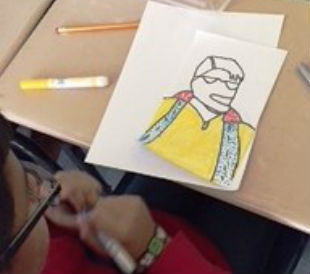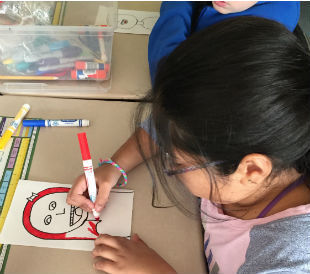
Visual artist Lucienne Pereira recently collaborated with South Huntington fifth grade teachers on an arts-based project designed to help students interpret and express their individuality. To prepare for the project, the classes read Fish in a Tree by Lynda Mullaly Hunt. The story’s uplifting message ("Everybody is smart in different ways. But if you judge a fish by its ability to climb a tree, it will live its life believing it is stupid") was used as inspiration for the students’ self-portraits.
During the first session of her residency, Ms. Pereira told students she would be guiding them in the creation of a self-portraits inspired by the artists of the 1960s and 1970s, including Andy Warhol, Roy Lichtenstein, and Robert Rauschenberg. The students would learn and apply various abstract and pop art techniques to their artwork. For example, they would learn about the speech bubbles and cartoon techniques used by Lichtenstein. They would also explore drawing and collage as well as words and images that describe themselves. During the first session, students created an abstract watercolor painting (below) to act as the background for their artwork.


In the next session, the teaching artist shared a PowerPoint presentation and discussed Roy Lichtenstein (above). She noted that the artist created enlarged cartoon images with thick outlines, primary colors, and Ben Day dots meant to give the hand-made art a machine-made look. Next, Ms. Pereira demonstrated how to begin a cartoon-portrait (below). She emphasized that a cartoon is simple and a caricature. The students observed Lichtenstein’s Girls with Hair Ribbon.

The students began worked on their self-portraits, drawing and using only blue, red and yellow paint. To simulate skin color they created red dots.




When the cartoons were finished, the children cut them out (below).
Ms. Pereira distributed a handout with questions, such as “What would you like people to know about you? What one thing makes you very happy? What one thing makes you unhappy or angry?” She explained that the students would be adding speech bubbles that contained words that expressed their feelings and special qualities. The bubbles were created and cut out.
“The classroom teachers were extremely supportive,” stressed the teaching artist. “They helped the students make connections throughout the project.” For example, they made references to the book’s main character, Ally. "The teachers encouraged the students to express things about themselves that weren’t known to their classmates. They acknowledged and praised the students' efforts.”

In subsequent sessions, the students’ portraits and speech bubbles were adhered to their watercolor backgrounds. After observing collages by artist Robert Rauschenberg, the students searched catalogs, newspapers and magazines for images that were popular and expressed their personal tastes. These images were also cut out and glued to the students’ artworks.
The students also explored works by Andy Warhol. They were given a print of Warhol’s iconic Campbell Soup Can with a blank flavor description. After reading a passage from Fish in a Tree, in which the main character compared herself to a can of soup, the students wrote character traits as their soup flavor. The students colored the soup can and glued it onto their portraits.
During the project, the fifth graders traveled to Heckscher Museum to see an exhibit entitled From Frankenthaler to Warhol: Art of the '60s and '70s. The field trip was discussed during the residency’s final session. “We spoke about the museum, discussing the artworks the students like most, and what they recognized from the class discussions and their own artworks,” said Ms. Pereira. Afterwards, the students finished their portraits and the teaching team took photographs. Inspired by the museum exhibit, the classroom teachers prepared an exhibit of the students’ work for the school hallway.


“The project gave the students the opportunity to say things about themselves—their character traits, and things they liked and disliked—that they wanted people to know about them,” noted Ms. Pereira. “They revealed things they do in their homes, problems with bullying, qualities that they have, things they hate.”
